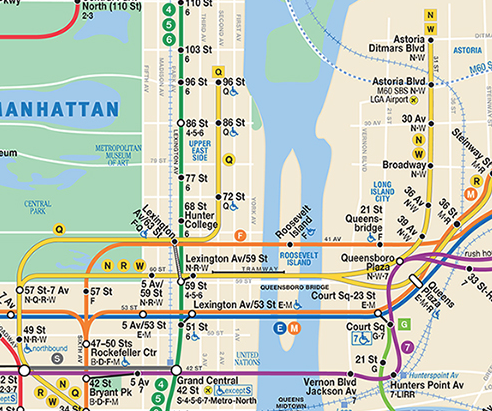The Second Avenue subway is good news for the UES, but in Astoria? Maybe not so much
Since its opening on New Year's Day, the Second Avenue subway has mostly delighted far Upper East Side residents who previously had to schlep to Lexington Avenue trains, which were bursting at the seams with commuters. One Brick staffer who lives in Yorkville wrote that the three new stations were worth the wait, and according to the New York Times, regular 4/5/6 train passengers have reason to celebrate, too: Ridership on that overcrowded line has fallen and its trains are running a little closer to schedule.
But while Upper East Siders are enjoying public works of art and a fleet of Q trains from the new stations, some Astorians are complaining that their local line has taken a hit, citing an increase in delays, and more crowded, slower-moving trains.
Before the Second Avenue subway opened, the N and Q trains ran from Astoria-Ditmars Boulevard into Manhattan, meeting up with the R train from Forest Hills at 59th Street/Lexington Avenue. With the debut of the new subway line, the Q was re-routed to run from 57th Street-7th Avenue up to its terminus at 96th Street; the W train—phased out in 2010—was brought back to replace the Q.

It seems, though, that the W is not an adequate replacement for the Q, given the number of locals who have taken to Twitter with their transit grievances:
@mta For 1 hour no Astoria N train at times square, seriously?
— Nazar (@Watcher1984) March 5, 2017
@NYCTSubway Another day, another empty R train followed by 2 totally packed N/W. Do you think maybe we need more trains to Astoria?
— Danny A (@astoriadan) March 2, 2017
N/W trains from astoria are a mess this morning. First time in my life I actually miss the 6 train. Get it together @MTA @NYCMTA_Problems
— George Bakalis (@bakalis_george) February 27, 2017
On Reddit, Astorians were also complaining about an apparent decline in N/W service. One user wrote that the subways had become "atrocious... They have been stopping every 5 seconds and been incredibly packed. What gives?" Another replied that the Second Avenue subway is, indeed, the culprit: "Reduction in service for both the R and N due to the Q train, another factor in the disaster that is the MTA." (The MTA did not respond when Brick reached out for comment.)
And these accusations likely aren't just sour grapes that another corner of the city got a major transit upgrade. Back when the W's return was announced, DNAInfo wrote that the switch from Q to W meant over 20 fewer trains heading to and from the neighborhood.
The reductions in service take place during the wee hours of the morning and the late evening, though, with the same amount of trains running during rush hour, which means the problems Astorians are reporting may have more to do with the subway overall, rather than just the new Second Avenue line.
The Times reported recently that there has been a performance decline throughout the subway system, with MTA data indicating that over the past five years, the number of delays have doubled and train breakdowns have increased, while ridership has soared to higher numbers than ever before.
The latter seems likely to be part of the problem in Astoria, where the local labor force—that is, residents working or seeking work—has risen by 12.4 percent since 2000, according to the NYC Economic Development Corporation.
A potential source of hope for transit-weary locals? The DNAInfo story mentions that the MTA will track ridership data on the N/Q/W lines and make scheduling changes as needed. If Astorians' grievances are to be believed, the agency couldn't possibly miss the problems on the neighborhood's trains.
You Might Also Like




























